42 Plants with Shallow Roots That Thrive in Shallow Soil
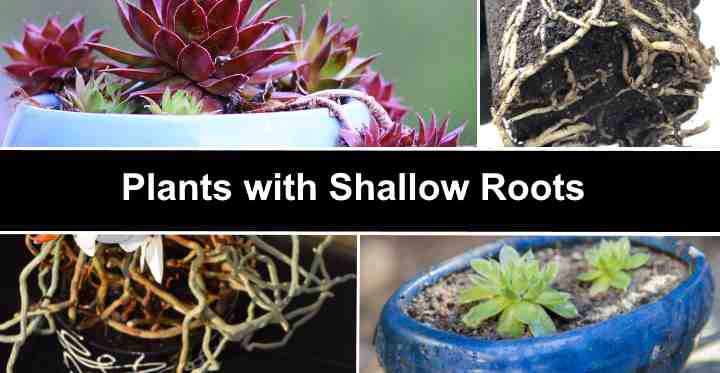
Plants with shallow roots are useful landscaping plants if areas of your garden lack deep soil. Shallow-rooted plants help to prevent soil erosion, suppress weeds, and stabilize the soil on slopes. Additionally, plants with shallow roots are ideal for ground cover, especially if your front or backyard has compacted or shallow soil.
Not every plant needs lots of soil to grow well. Actually, quite a few plants with shallow roots do really well in gardens that don’t have deep soil. Plants like lavender, periwinkle, zinnias, and petunias can make your garden full of life and color, even where other plants might struggle.
By choosing shallow-rooted plants, you can still have a beautiful and thriving garden without needing deep, rich soil. We’ll show you the best plants for shallow soil areas, including flowers that bloom every year, plants that come back every year, and plants that are just for looking at or even eating, all of which have shallow roots.
Why Grow Plants With Shallow Roots?
Plants with shallow roots are beneficial for erosion control, ground cover, understory planting, and low-maintenance landscaping. Their extensive root systems help bind the soil together. Additionally, since they don’t grow deep roots, these plants are ideal for companion planting because they don’t compete for nutrients with deep-rooted shrubs
Let’s have a look at several scenarios where considering shallow-rooted plants in a garden setting is important:
Erosion Control: Shallow-rooted plants are excellent for stabilizing soil and preventing erosion, especially in sloped areas or regions prone to heavy rains. Their roots bind the soil together, reducing runoff and soil loss.
Planting in Problematic Areas: In areas with rocky soil, compacted layers, or hardpan close to the surface, deep-rooting plants might struggle to establish. Shallow-rooted varieties can thrive in these conditions, allowing for successful gardening in challenging sites.
Companion Planting: Shallow-rooted plants can be great companions to deeper-rooted species. They can coexist without competing for nutrients and water, promoting a diverse and healthy garden ecosystem.
Ease of Transplanting: Plants with shallow roots are generally easier to transplant since their root systems are more compact and less likely to be damaged during the process. This makes them ideal for gardeners who like to rearrange their plants or move them as they grow.
Ease of Care: Gardens designed with shallow-rooted plants often require less intensive soil preparation and can be easier to maintain. These plants can thrive in shallow soils and may require less watering depth, making them suitable for raised beds and containers.
Some of the best plants with shallow roots are creeping phlox, African violets, petunias, and periwinkle. These shallow-rooted varieties spread over thin soil, creating a carpet of color.
What Makes a Great Plant for Shallow Pots?
The best plants for shallow pots have root systems that don’t go deep down. Many of the best plants for shallow pots are drought-tolerant, low-maintenance, and adapt to various conditions. Their ability to thrive in limited soil depth lets you enjoy their foliage, flowers, and decorative beauty in small spaces or shallow containers.
What is Considered a Shallow Pot?
A shallow pot, often referred to as a low or shallow planter, typically has a height that is much less than its diameter. These pots are designed to accommodate plants with shallow root systems and are usually no more than 6 to 8 inches deep (15 – 20 cm).
Shallow pots are ideal for plants that do not require a lot of soil depth to thrive, such as succulents, some herbs, and ground cover species. They are also used for creating bonsai, as the limited space helps to restrict root growth and maintain the miniature size of the trees. The design of shallow pots not only caters to the horticultural needs of certain plants but also offers aesthetic variety for indoor and outdoor gardening, allowing for creative arrangements of plants with similar shallow root requirements.
Flowering Plants with Shallow Roots
Flowering annuals and perennials with shallow roots are important landscaping plants. They are easy to establish in a yard and have many uses, like ground cover, planting in shallow soil, erosion control, and weed suppression.
Let’s look in detail at the best shallow-rooted flowering plants.
Flowering Annual plants With Shallow Roots
Moss Rose (Portulaca grandiflora)

Moss rose is a colorful, low-growing annual plant with a shallow root system, fleshy leaves, and colorful flowers. The pink, yellow, orange, red, and white flowers have ruffled petals and measure 1” (2.5 cm) across. They bloom from late spring until frost. These flowers contrast nicely with the bright green, needle-like, fleshy, succulent leaves.
Moss rose, with its succulent foliage, reddish stems, and colorful flowers, doesn’t grow taller than 6” (15 cm). Due to its shallow roots, it requires regular watering to get established. Once established, it’s drought-tolerant and thrives in poor, well-drained shallow soils. Moss rose is ideal for rock gardens, containers, ground cover, and hanging baskets.
- USDA Growing Zone: 2 to 12
- Light: Full sun
- Bloom Time: Late spring throughout summer until late fall
- Watering Needs: Regular watering until established
- Soil Needs: Dry to moderately moist poor soils
Petunia
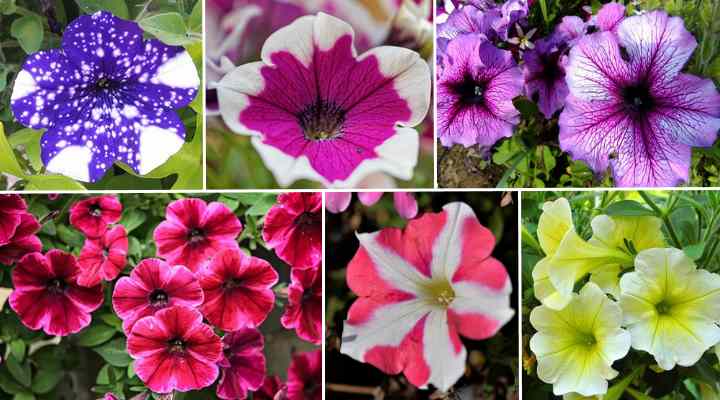
Petunias are popular flowering plants that require regular watering due to their shallow roots. The trumpet-shaped flowers bloom throughout summer until late fall. They have vibrant pink, red, purple, and white colors. These attractive bedding plants require little maintenance and attract bees, butterflies, and hummingbirds to yards.
Petunias bloom prolifically throughout the seasons. Depending on the variety, they grow 0.5 to 2 ft. (0.15 – 0.6 m) tall and wide. Due to their shallow roots, petunias require regular watering, especially during hot and dry periods. Landscaping ideas for these flowering annuals include window boxes, hanging baskets, and borders.
- USDA Growing Zone: 2 to 11
- Light: Full sun
- Bloom Time: Late spring to frost
- Watering Needs: Regular watering, especially during hot periods
- Soil Needs: Well-drained soil, rich in organic matter
Zinnia

Most varieties of zinnias have shallow root systems because they are annuals. The fast-growing, popular flowering plants have showy, colorful blooms, many of which have multiple rows of petals. The daisy-like flowers bloom throughout summer in vibrant pink, red, orange, yellow, and purple colors. These contrast with lush, dark green lanceolate leaves.
Zinnias grow 3 to 4 ft. (0.9 – 1.2 m) tall in full sun and well-drained soil. They are drought-tolerant once established and are low-maintenance plants. Zinnias perform well in borders, mixed beds, and containers.
- USDA Growing Zone: 2 to 11
- Light: Full sun
- Bloom Time: Early summer to frost
- Watering Needs: Moderate, but drought, heat, and rain-tolerant
- Soil Needs: Well-drained, humus-rich fertile soil
Marigold (Tagetes)

Marigolds are popular annual flowers known for their bright and cheerful yellow or orange blooms. Ideal for planting in shallow ground, marigolds bloom from late spring until frost in yellow, red, and orange shades. The tall leafy stems have fern-like foliage, growing 1 to 4 ft. (0.3 to 1.2 m) tall and 2 ft. (0.6 m) wide.
Marigolds are easy to grow and thrive in full sun and well-drained soil. Their blooms can be pompom-like, daisy-like, or ray flowers. Uses for marigolds include flower beds, borders, and containers. Also, their shallow roots mean they are ideal for companion planting. Deadheading encourages continuous blooming throughout the growing season.
- USDA Growing Zone: 2 to 11
- Light: Full sun
- Bloom Time: Late spring to first frost
- Watering Needs: Moderate water needs, but increase watering frequency in hot weather
- Soil Needs: Moderately fertile, well-drained soil
Nasturtium (Tropaeolum majus)

Nasturtium is a group of flowering, warm-season annual plants with round, shield-shaped leaves, and colorful flowers. The red, orange, and yellow funnel-shaped flowers measure up to 3” (7.5 cm) wide. Depending on the variety, the nasturtium plants grow as a bushy mound, trailing plant, or climber up to 10 ft. (3 m) tall.
Fast-growing nasturtiums thrive in full sun through summer and fall. Other names for the flowering annuals include Indian cress or Mexican cress—alluding to the spicy taste of the edible leaves and flowers. Nasturtium plants are useful in landscapes for adding vertical accent, covering fences, or ground cover in full sun.
Nasturtiums attract pollinators like bees and butterflies to the garden and are deer-resistant.
- USDA Growing Zone: 2 to 11
- Light: Full sun to partial shade
- Bloom Time: Early summer to fall
- Watering Needs: Requires regular watering to get established and throughout the season
- Soil Needs: Poor, well-draining soil
Pansy (Viola tricolor)

Pansies are popular for their vibrant and varied flower colors, including combinations of yellow, purple, white, and blue, among others. These annuals have shallow roots and spread through shallow rhizomes, making them suitable for shallow pots and vibrant garden displays. The plants typically grow up to 6 inches (15 cm) tall, bringing color to gardens in early spring and fall, thanks to their cool temperature tolerance.
Pansies flourish in well-drained soil and enjoy a mix of full sun and partial shade. To encourage continuous blooming, regular watering is essential, but it’s important to avoid waterlogged conditions. Deadheading spent flowers can also promote more blooms. With their versatility, pansies are excellent for borders, containers, and ground cover, offering long-lasting color in the garden.
- USDA Growing Zone: 3 to 9
- Light: Full sun to partial shade
- Bloom Time: Spring and fall
- Watering Needs: Regular watering, keeping the soil consistently moist but not waterlogged
- Soil Needs: Rich, well-draining soil with a slightly acidic pH
Perennial Flowering Plants with Shallow Roots
Hardy Ice Plant (Delosperma)
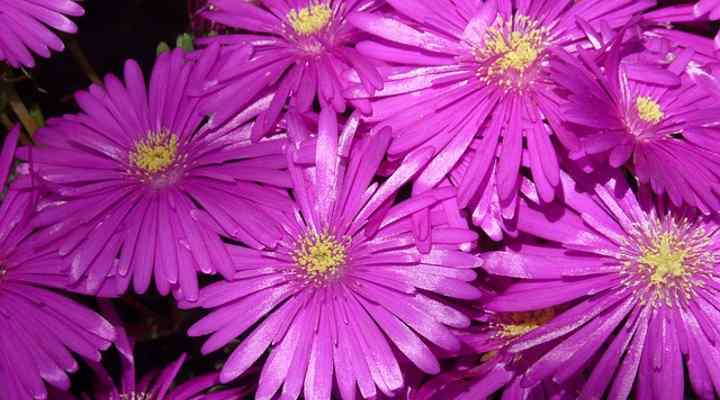
The hardy ice plant is a vigorous mat-forming perennial with purple-pink daisy-like flowers. Its fast growth and shallow root system make it ideal for creating vibrantly colorful ground cover in poor soil. Identifying features of the plant are its colorful ray flowers, fleshy, succulent-like foliage, and long blooming time. It tolerates salt, heat, and drought.
The hardy ice plant grows up to 6” (15 cm) tall. Its shallow-spreading rooting system is ideal for ground cover, rock gardens, slopes, banks, and shallow containers. It’s also an excellent addition to coastal gardens as it’s resistant to salt spray and gravelly or sandy soil.
- USDA Growing Zone: 6 to 10
- Light: Full sun
- Bloom Time: Throughout summer
- Watering Needs: Low water needs, allow soil to dry between watering
- Soil Needs: Well-drained sandy soil
Sea Thrift (Armeria maritima)

Sea thrift is a low-growing, clumping, shallow-rooted perennial plant with clusters of pink flowers and needle-like leaves. Native to coastal regions, sea thrift features small mounds of grass-like foliage with ball-shaped pink flower clusters on slender stalks. The charming pink-flowering plant is easy to grow in infertile, dry soils.
Sea pinks thrive in sandy, salty, and windy conditions, making them an excellent choice for coastal gardens. Not growing taller than one foot (30 cm), the mounded tufts spread slowly, creating evergreen ground cover. Landscaping uses for the pink perennial include border fronts, rock gardens, edging, and pollinator gardens.
- USDA Growing Zone: 3 to 9
- Light: Full sun to part shade
- Bloom Time: Early spring to early summer
- Watering Needs: Low as it tolerates drought and dry soils
- Soil Needs: Sandy, well-drained soil
Creeping Baby’s Breath (Gypsophila repens)
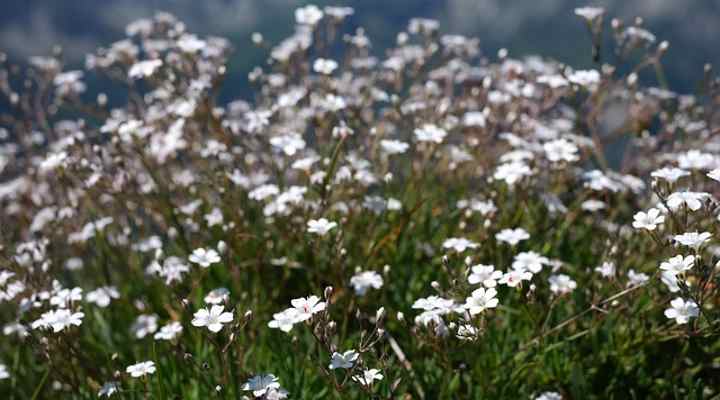
Creeping baby’s breath is a delicate, low-growing perennial plant with tiny white star-shaped flowers. Like many low-growing, creeping plants, this species has shallow roots, making it ideal for growing in dry ground and rock gardens. Its mat-forming habit means the plant grows 8” (20 cm) tall and up to 20” (50 cm) wide.
The small, starry, five-petalled flowers bloom in light purple, white, or lilac clusters above a carpet of narrow, gray-green foliage. This ground cover plant is ideal for growing in rock gardens, borders, or containers. Once established, creeping baby’s breath plants are drought-tolerant and require minimal watering.
- USDA Growing Zone: 3 to 9
- Light: Full sun
- Bloom Time: Late spring to early summer
- Watering Needs: Moderate, requiring regular watering in the hottest months to prevent the soil from drying out
- Soil Needs: Well-draining, slightly alkaline, or neutral soil
Rhizomatous Geranium (Geranium macrorrhizum)
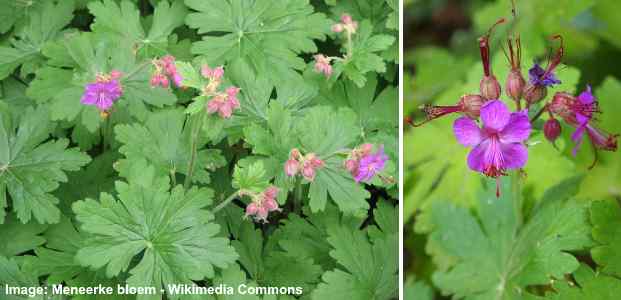
Rhizomatous geranium is a pink-flowering evergreen perennial with thick yet shallow roots. Also called bigroot geranium, the versatile plant has deeply lobed, round, aromatic leaves with five to seven lobes. It blooms in late spring and early summer with long-lasting purple-pink flowers that bloom in umbrella-like clusters (umbels).
Bigroot geranium has a spreading habit and grows 1.5 ft. (0.45 m) tall and 2 ft. (0.6 m) wide. The plant’s robust and shallow root system is ideal for weed-suppressing ground cover, soil erosion, and dry soils. It also performs well in full sun in border fronts, rock gardens, or cottage gardens.
- USDA Growing Zone: 4 to 8
- Light: Full sun to partial shade
- Bloom Time: Late spring to early summer
- Watering Needs: Low to moderate water requirements
- Soil Needs: Well-draining soil, tolerant of various soil types
Upright Stonecrop (Sedum)

Upright stonecrop has shallow roots, making it ideal for growing in pots or shallow gardens. The versatile perennial is characterized by its fleshy green leaves and pink flower clusters. The flat-topped flowering clusters bloom throughout summer and fall atop stems growing 2 ft. (0.6 m) tall.
Upright stonecrop is a low-maintenance plant that is drought-tolerant and thrives in poor, well-drained soil. The pink flowers turn rich rose-colored during the season before becoming coppery-rust before dropping. Landscape ideas for upright stonecrop plants include mixed borders, butterfly gardens, and rock gardens. The long-lasting flowers provide nectar for late-season pollinators. Their easy-care nature and resistance to pests make them a favorite among gardeners.
Sedum thrives in full sun to partial shade and requires well-drained soil to prevent root rot. Once established, it needs minimal watering, making it an excellent choice for water-wise gardens.
- USDA Growing Zone: 3 to 9
- Light: Full sun to partial shade
- Bloom Time: Mid-summer to late fall
- Watering Needs: Infrequent watering once established
- Soil Needs: Well-drained soil that can tolerate poor soil conditions
African Violet (Streptocarpus sect. Saintpaulia)

African violet is a popular houseplant with shallow roots, velvety leaves, and delicate purple flowers. The purple-flowering plant performs best in shallow pots, allowing the potting soil to dry quickly. These tropical houseplants bloom indoors throughout the year with purple, white, or pink flowers. Also, the dark green, fuzzy leaves add to the plant’s charm.
African violets are easy to grow indoors if they grow in shallow containers with a well-draining potting mix. It performs best in bright, indirect light and requires around ten hours of sunlight daily for compact, bushy growth.
- USDA Growing Zone: 11 and 12 (usually grown as a houseplant)
- Light: Bright, indirect light
- Bloom Time: Throughout the year
- Watering Needs: Keep soil consistently moist but not waterlogged
- Soil Needs: Well-draining potting mix
Geranium (Pelargonium)

Pelargonium spp., commonly referred to as geraniums, are versatile, shallow-rooted plants ideal for brightening up your garden and home. They have a stunning array of blooms in red, pink, white, and purple, complemented by their distinctive thick, fleshy leaves with scalloped edges. While Pelargonium can be grown outdoors year-round in USDA Zones 9 to 12, in cooler climates, they are often treated as annuals or overwintered indoors.
Geraniums adapt well to growing in pots, making them perfect plants for shallow containers, hanging baskets, and window boxes. They also thrive in garden beds, adding color to low-water gardens, xeriscaping, borders, rock gardens, and edgings. The sun-loving Pelargonium varieties range from upright to trailing forms, with ivy-leaved Pelargoniums (Pelargonium peltatum) known for their cascading beauty in hanging displays.
Despite their delicate appearance, Pelargoniums are drought-tolerant once established and require minimal maintenance. Their vibrant colors and varied forms make them a favored choice among gardeners seeking to add long-lasting color and texture to their plant collections. Whether you’re dressing up your outdoor landscape or bringing a splash of color indoors, Pelargoniums provide beauty and versatility with minimal fuss.
- USDA Growing Zone: 9 to 12
- Light: Full sun or partial shade
- Bloom Time: Late spring to early fall
- Watering Needs: Regular, deep watering without allowing the soil to become waterlogged
- Soil Needs: Well-draining soil
Saxifrage (Saxifraga spp.)
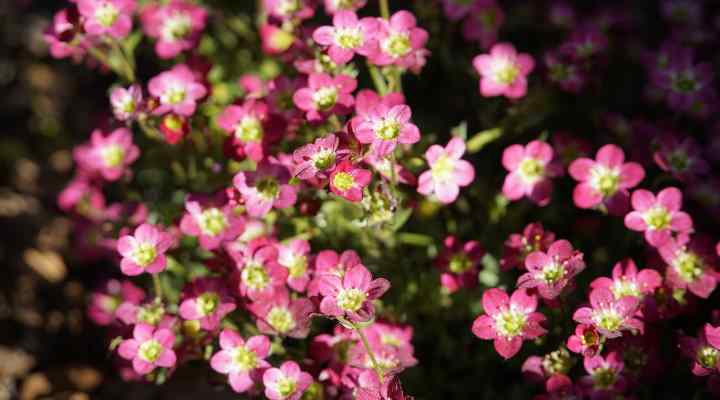
Saxifrage is a diverse group of perennial plants with shallow roots, suitable for shallow pots and rock gardens. Its name means “stone breaker,” implying its ability to grow in rocky, challenging conditions. Saxifrage forms low, compact mounds of foliage, often with attractive, scalloped or variegated leaves. The small, attractive flowers bloom in clusters on thin, wiry stems above the foliage, providing a delicate appearance.
Ideal for alpine gardens, borders, and as ground cover, saxifrage thrives in cool, moist conditions. It prefers partial shade but can tolerate full sun in cooler climates. With its shallow roots, it needs well-drained soil and regular watering during dry spells. Saxifrage’s resilience and charming flowers make it a favorite among gardeners looking for low-maintenance yet visually striking plants.
- USDA Growing Zone: 4 to 9
- Light: Full sun to partial shade
- Bloom Time: Spring to early summer
- Watering Needs: Moderate, prefers consistent moisture
- Soil Needs: Well-drained, humus-rich soil
Ground Cover Plants With Shallow Roots
Shallow roots are a feature of many ground cover plants. Plants with shallow roots are suitable for ground cover because they spread quickly and easily. This way, they easily form a thick carpet-like cover over the soil. This helps to prevent erosion, suppress weeds, and retain moisture in the ground.
Periwinkle (Vinca spp.)
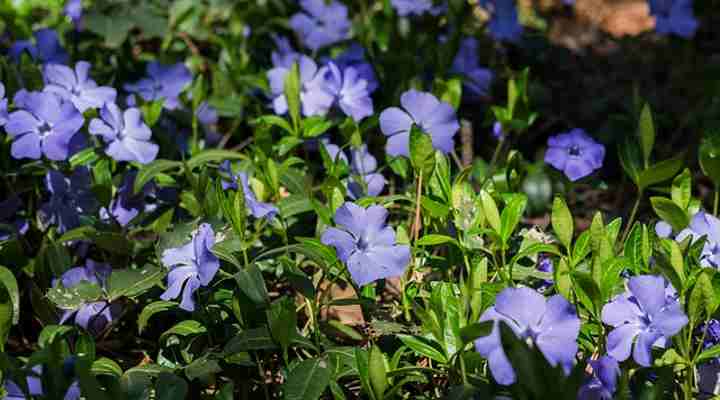
Periwinkle is a vigorously trailing evergreen plant with spreading roots that grow on the ground’s surface. Features of shallow-rooted periwinkle plants are their five-petalled, star-shaped violet-blue flowers, glossy green, ovate leaves, and lush, dense foliage. The mat-forming perennials spread up to 2 ft. (0.6 m) wide, and the flowers are 1.5” (4 cm) across.
Periwinkle is a hardy, drought-tolerant plant that thrives in dry soils and full sun to full shade. The trailing stems create dense ground cover and perform well on slopes and banks. Additionally, you can grow purple-flowering periwinkle in shallow containers, hanging baskets, and window boxes.
Its tolerance to full shade makes it an excellent plant for underplanting shrubs or trees. Lesser periwinkle (Vinca minor) is more cold-hardy than big periwinkle (Vinca major).
- USDA Growing Zone: 4 to 9, depending on the variety.
- Light: Full sun, partial shade, dappled sunlight, and deep shade
- Bloom Time: Spring and summer
- Watering Needs: Low watering requirements once established
- Soil Needs: Well-drained soil
Creeping Phlox (Phlox subulata)
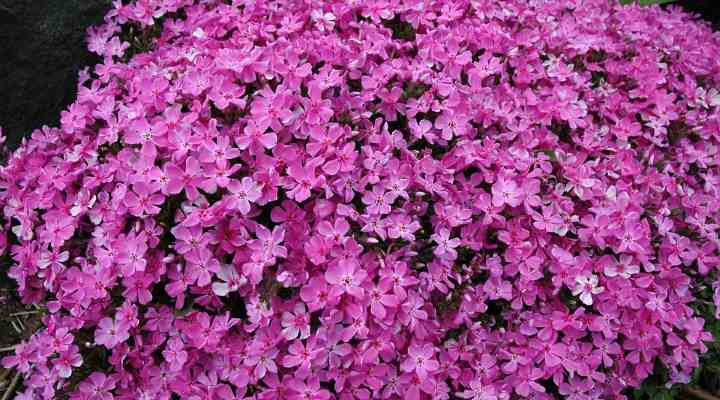
Also called moss phlox, creeping phlox is a shallow-rooted, low-growing perennial plant that blooms in spring with vibrant pink flowers. The popular ground cover plant features needle-like foliage and five-petaled, star-shaped flowers. The shallow roots quickly spread along the ground, forming a dense, colorful mat.
Creeping phlox grows up to 2 ft. (0.6 m) wide and 6” (15 cm) tall. The hardy evergreen is ideal for erosion control on banks and slopes, growing between stepping stones, or covering ground in full sun. Additionally, its fragrant pink flower attracts butterflies, bees, and hummingbirds.
- USDA Growing Zone: 3 to 9
- Light: Full sun to partial shade
- Bloom Time: Spring
- Watering Needs: Regular watering to establish the root system and become drought-tolerant
- Soil Needs: Well-draining rocky or sandy soils
Creeping Jenny (Lysimachia nummularia)
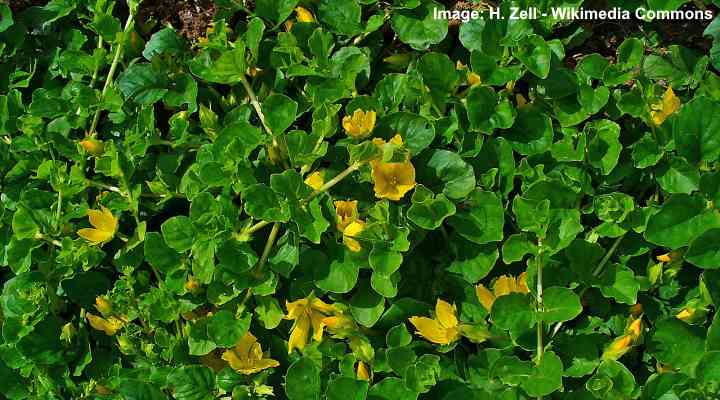
Creeping Jenny—or moneywort—is a low-growing perennial plant that spreads through slender, shallow-growing rhizomes. Features of the vigorous mat-forming plant are its cup-shaped yellow flowers, which are 0.75” (2 cm) wide, and trailing stems with ovate, bright green leaves. Creeping Jenny blooms throughout summer. It’s a popular plant for ground cover in sunny to partially shaded areas.
Creeping Jenny prefers consistently moist soil, even tolerating wet conditions. It only grows a few inches tall and readily roots where stem nodes contact the ground. Its trailing stems and brightly colored foliage make it well-suited for cascading over walls, shallow containers, or hanging baskets. It’s best to plant it away from lawns as it can quickly become a lawn weed.
- USDA Growing Zone: 3 to 8
- Light: Full sun to partial shade
- Bloom Time: Summer, however blooming can be sporadic
- Watering Needs: Consistently moist soil
- Soil Needs: Moist, well-drained soil, but can tolerate wet conditions.
Coral bells (Heuchera)
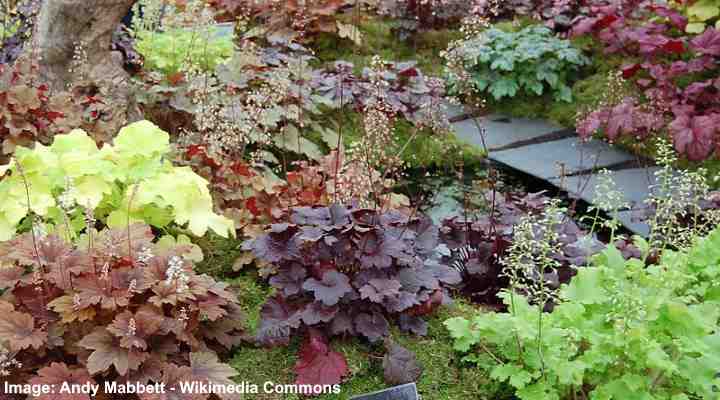
Coral bells is a group of colorful foliage plants with a shallow root system. The outstanding feature of coral bells is the showy triangular leaves in a range of green, purple, silver, and red hues. Many varieties have marbled or veined patterns and wavy margins. The ground cover foliage plant also blooms in summer with small bell-shaped flowers blooming on slender stalks.
Coral bells grow 0.5 to 2 ft. (0.15 – 0.6 m) tall and wide. Apart from growing as colorful ground cover in dry shade, the bright foliage of coral bells looks spectacular in rock gardens, borders, beds, on slopes, and along path edges. Their shallow roots mean they also grow well in small pots.
Because the plant genus is vast and varied, you must check specific growth requirements for your climate and zone.
- USDA Growing Zone: 4 to 9
- Light: Full sun, dappled sunlight, partial shade, or full shade.
- Bloom Time: Late spring to early summer
- Watering Needs: Regular watering, especially in hot weather
- Soil Needs: Well-draining soil; however, some varieties perform well near ponds and streams
Hosta (Hosta)

Hostas, also known as plantain lilies, are a staple in shade gardens, known for their lush foliage and adaptability. These perennials have a shallow, rhizomatous root system, allowing them to thrive under a canopy of trees or alongside deep-rooted shrubs. Hostas are available in a wide array of leaf colors, patterns, and sizes, ranging from blue-green to variegated with white or yellow margins.
Typically, hostas form dense mounds of foliage, which can vary significantly among cultivars—from miniature varieties that barely reach 6 inches in height to large, sprawling types that can grow up to 2 feet tall and spread 3 to 4 feet wide. In summer, they produce spikes of bell-shaped flowers, ranging in color from white to lavender, adding an extra layer of interest to the garden.
Despite their preference for shade, hostas are remarkably versatile and can tolerate a range of light conditions, from partial to full shade. They excel as ground cover in shaded areas, where their extensive root systems help prevent soil erosion and suppress weed growth. Additionally, their ability to grow in shallow soil makes them ideal candidates for underplanting beneath taller plants or in shallow pots where soil depth is limited.
- USDA Growing Zone: 3 to 9
- Light: Partial shade to heavy shade
- Watering Needs: Allow soil to dry out between waterings
- Soil Needs: Well-draining, fertile soil that is protected from cold, dry winds
Moss (Bryophyta spp.)

Moss is a simple, non-flowering plant with a very shallow root system, making it exceptional for shallow pots and terrariums. Thriving in moist, shaded areas, moss creates a lush, green carpet over the soil. It lacks true roots, relying on rhizoids to anchor to the ground, allowing it to grow on various surfaces, including rocks, trees, and bare soil. Moss is versatile, requiring minimal nutrients, making it perfect for creating a tranquil, green landscape in shaded gardens.
Due to its shallow root-like structures, moss is excellent for covering ground in shady gardens or creating a natural, woodland feel. It prefers low-light conditions and moist environments but can tolerate periods of dryness once established. Moss is a low-maintenance option for adding texture and a deep green hue to garden designs, walls, and water features. Its ability to thrive in difficult conditions makes it a useful plant for challenging garden spots.
- USDA Growing Zone: 3 to 9
- Light: Partial to full shade
- Watering Needs: Prefers consistent moisture but can tolerate some dryness
- Soil Needs: Prefers acidic, well-drained soil but can grow on various substrates
Foliage Plants for Shallow Pots
Nerve Plant (Fittonia)
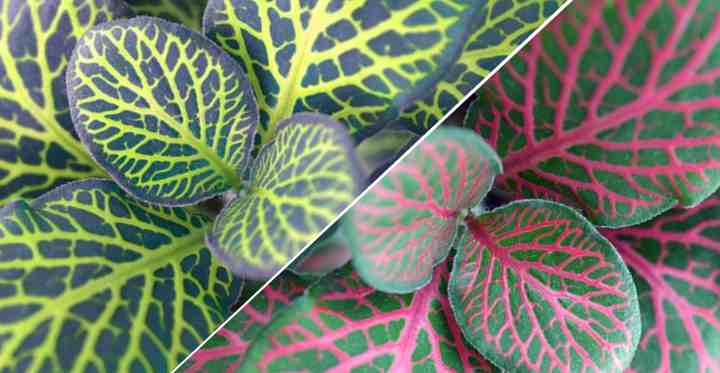
Nerve plant is a beautiful houseplant with striking foliage and shallow roots. Ideal for growing in shallow pots or terrariums, the compact plant has small, deep green leaves with contrasting pink, white, or red veins. The gorgeous, eye-catching foliage plants grow up to 6” (15 cm) tall and 18” (45 cm) wide.
Nerve plants are relatively low-maintenance and thrive in humid environments. They thrive indoors in bright, indirect light and moist, well-drained soils. Because they are native to tropical climates, they are popular indoor plants for small, shallow pots or terrariums.
- USDA Growing Zone: 11 and 12, therefore primarily suitable for indoors
- Light: Bright, indirect light
- Watering Needs: Keep soil consistently moist
- Soil Needs: Well-draining potting mix
Succulents

Most succulent houseplants have shallow roots and thrive in squat containers or shallow pots. Succulents have roots that spread near the soil’s surface. Therefore, they are ideal low-maintenance plants for growing indoors. They come in various shapes, sizes, and colors, making them popular for indoor and outdoor gardening. Popular houseplant succulents include echeveria, aloe, haworthia, and zebra cactus.
The thick, fleshy leaves of succulents store water, allowing them to thrive in arid conditions. They require minimal care, making them ideal for busy or novice gardeners. For best results, place succulents in bright, indirect light and well-drained soil. They prefer infrequent watering, allowing the soil to dry between waterings. Overwatering can lead to root rot, the most common issue with succulents. Their shallow roots make them excellent choices for rock gardens, terrariums, and window sills. Succulents add texture and interest to any garden space.
- USDA Growing Zone: Varies by species
- Light: Bright, indirect sunlight if grown indoors. If grown outdoors: full sun to partial shade
- Bloom Time: Varies by species
- Watering Needs: Minimal, allow soil to dry out between waterings
- Soil Needs: Well-draining soil
Boston Fern (Nephrolepis exaltata)
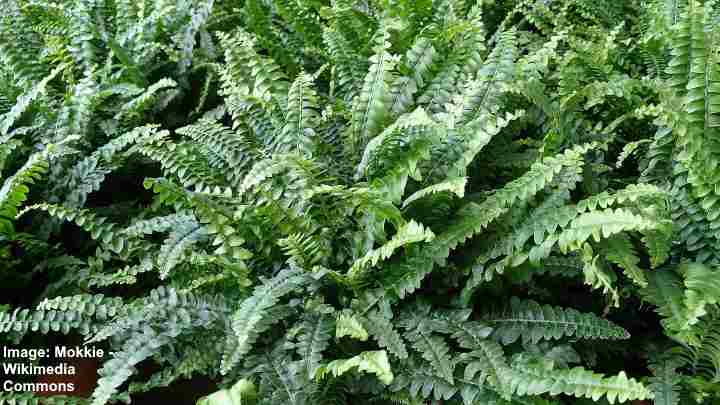
Boston fern is a popular houseplant with beautiful, arching, feathery fronds that can reach up to 3 feet (0.9 meters) long. The tropical ferns have shallow, spreading roots. Therefore, the pot should be wide enough for the root to spread. Its lush pinnate leaves make it an ornamental plant for shaded conditions in high humidity.
Boston ferns grow in the ground in tropical locations. It spreads over the ground via underground rhizomes near the soil’s surface. The foliage plants prefer bright, indirect light but tolerate lower light conditions. Indoors, Boston ferns are bushy houseplants popular in hanging baskets.
- USDA Growing Zone: 9 to 11
- Light: Partial shade or deep shade
- Watering Needs: Keep soil consistently moist but not soggy and ensure high humidity
- Soil Needs: Well-draining, rich potting mix high in organic matter
Snake Plant (Dracaena trifasciata)

Snake plants are eye-catching succulent houseplants known for their tall, stiff, upright, strap-like, or pointed leaves. Due to their shallow root system, they must grow in shallow, wide pots. Typically, the underground rhizomes spread horizontally rather than vertically. Snake plants are easy-to-care-for houseplants.
Snake plants have stiff, upright, pointed leaves growing in a cluster or rosette pattern, and include many cultivars. The flat blades are 2” to 4” (5 – 10 cm) wide and up to 4 ft. (1.2 m) long. Snake plants grow indoors in partial shade and don’t require frequent watering.
- USDA Growing Zone: 10 through 12
- Light: Indirect light to low light
- Watering Needs: Allow soil to dry out between waterings
- Soil Needs: Well-draining potting mix, preferring dry soil
Baby’s Tears (Soleirolia soleirolii)
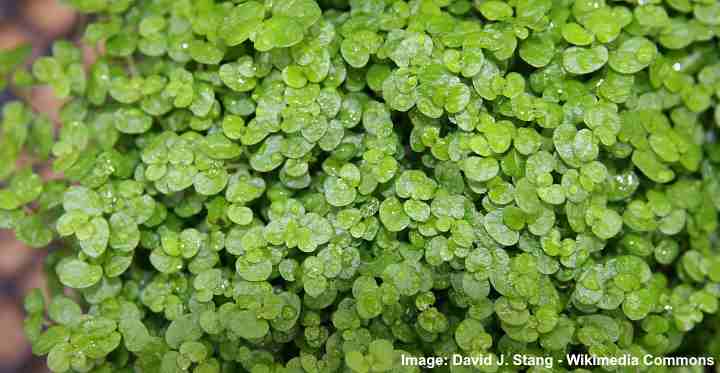
Baby’s Tears is a charming creeping perennial with a root system that grows near the soil’s surface. The tropical plant with small leaves grows as an attractive mound in shallow pots indoors. Its shallow roots also make it ideal for growing in terrariums. Its shiny, lime-green leaves spread across the ground.
Baby’s Tears thrives in the shade and grows outdoors in USDA Zones 9 and above. It can spread up to 6 ft. (1.8 m) wide in gardens in warm climates. However, it’s typically an attractive foliage plant for growing in shallow pots.
- Light: Indirect sunlight, partial shade, full shade
- Watering Needs: Regular watering to keep the soil consistently moist
- Soil Needs: Moist, well-draining soil
Peperomia (Peperomia)
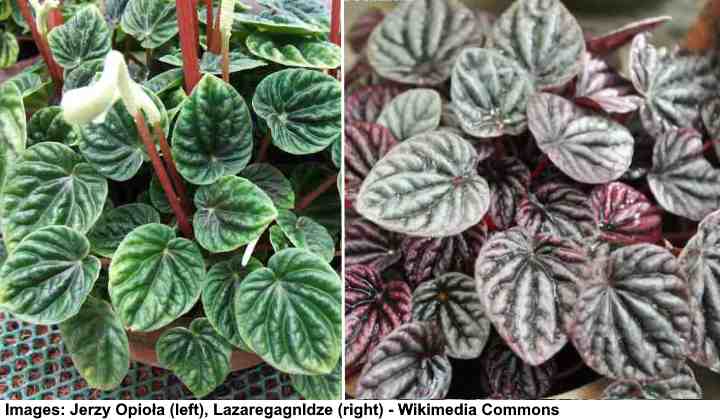
Peperomia is a genus of tropical foliage plants with a fine root system that doesn’t grow deep. Peperomia plants are known for their ornamental foliage and come in various shapes, sizes, and colors. Most varieties have thick, fleshy leaves that can be heart-shaped, pointed, round, or large, like rubber plants.
The slow-growing foliage plants generally grow 6” to 12” (15 – 30 cm) tall and wide. They rarely bloom indoors. Peperomia plants thrive when growing in well-draining potting soil, getting plenty of indirect light, and watered when the top layer of the soil in the container is dry.
- Light: Bright, indirect light for the best leaf color
- Watering Needs: Allow the top inch of soil to dry out between waterings
- Soil Needs: Well-draining potting mix
Golden Pothos (Epipremnum aureum)
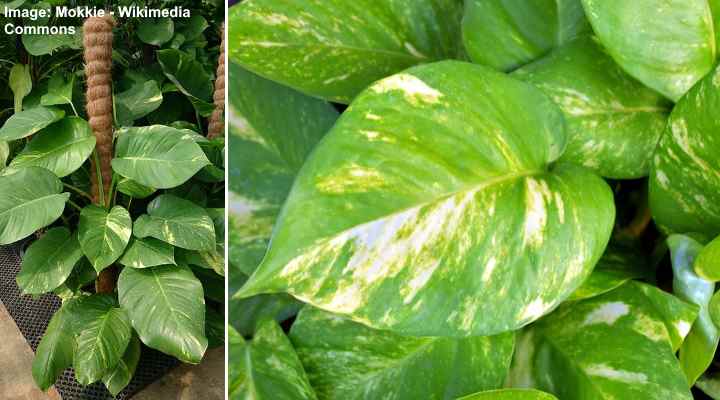
Golden pothos is a popular foliage plant with a shallow root system that thrives in small pots. The attractive tropical plant—also called devil’s ivy—is known for its heart-shaped, vibrant green leaves with yellow or white marbling. Its cordate or deltoid leaves grow on trailing vines up to 40 ft. (12 m) long.
Golden pothos is a trailing or climbing plant popular for growing in hanging baskets. Its shallow roots mean it thrives in smaller pots and requires little care. Additionally, studies suggest that golden pothos plants are one of the best houseplants for purifying the air indoors.
- Light: Dappled sunlight to deep shade
- Watering Needs: Allow the top inch of soil to dry out before watering
- Soil Needs: Well-draining potting soil mix
Ponytail Palm (Beaucarnea recurvata)
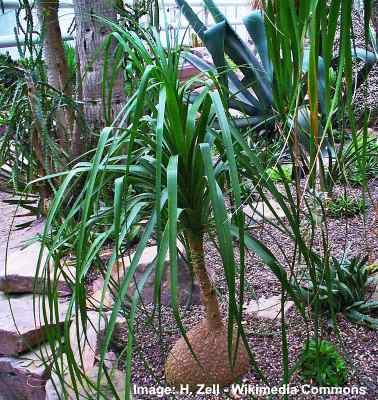
The ponytail palm is a succulent foliage plant with an attractive rosette of arching, pointed leaves atop a branchless stem with a swollen base. Also called the elephant’s foot plant, this tropical plant has a shallow root system compared to its size. Indoors, the small indoor decorative palm tree grows no taller than 8 ft. (2.5 m).
Despite its name, the ponytail palm is not a true palm. Instead, it’s a plant in the family Asparagaceae. Because of its shallow roots and tall stature, choose a shallow but wide ceramic or terracotta pot for stability.
- USDA Growing Zone: 9 to 11 outdoors
- Light: Bright, indirect light
- Watering Needs: Allow soil to dry out between waterings
- Soil Needs: Well-draining soil mix
Strawberry Begonia (Saxifraga stolonifera)
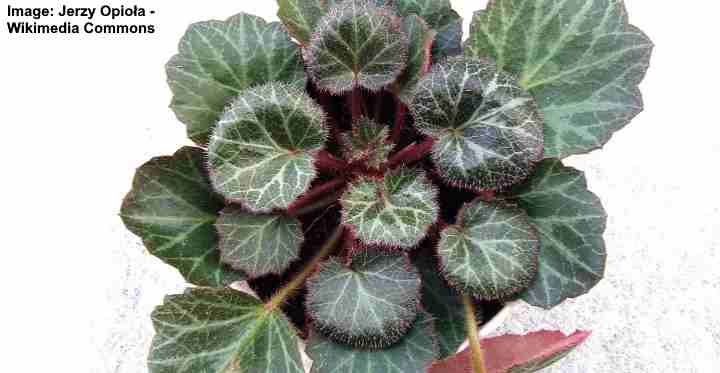
Strawberry begonia is a charming low-growing foliage plant with roots that grow just below the soil’s surface. The identification features of strawberry begonias are its rounded green leaves growing in basal rosettes and spreading veins on red runners. The leaves have scalloped edges, silvery-gray veins, and red undersides.
In spring and summer, strawberry begonia produces small, white flowers in airy clusters on delicate stems. Its tolerance for shade and shallow roots make strawberry begonia plants ideal for underplanting shrubs and trees. It also performs well in shade gardens as mat-forming ground cover, border greenery, or container planting.
- USDA Growing Zone: 6 to 9
- Light: Bright, indirect light when growing in shallow pots indoors
- Watering Needs: Keep soil consistently moist but not waterlogged
- Soil Needs: Well-draining, humus-rich potting mix
English Ivy (Hedera helix)

English ivy is a common evergreen vine with a fast growth habit which is suitable for covering fences and walls in shaded areas
English ivy is a shallow-rooted foliage plant that grows outdoors as an evergreen vine and indoors as a small potted houseplant. The evergreen perennial has glossy, dark green triangular leaves with three lobes growing on reddish stems. The most attractive English ivy cultivars have dark green leaves with creamy white veins and margins.
English ivy grows up to 30 ft. (9 m) tall outdoors. However, in shallow pots indoors, regular trimming keeps its size manageable. It’s a shade lover and performs well indoors in hanging baskets or small pots in bright, indirect light.
- USDA Growing Zone: 5 to 11
- Light: Full sun to full shade
- Bloom Time: Typically blooms in late summer to early fall, but the flowers are not very showy
- Watering Needs: Allow the soil to dry out slightly between waterings
- Soil Needs: Well-drained soil; can tolerate a variety of soil types
Spider Plant (Chlorophytum comosum)
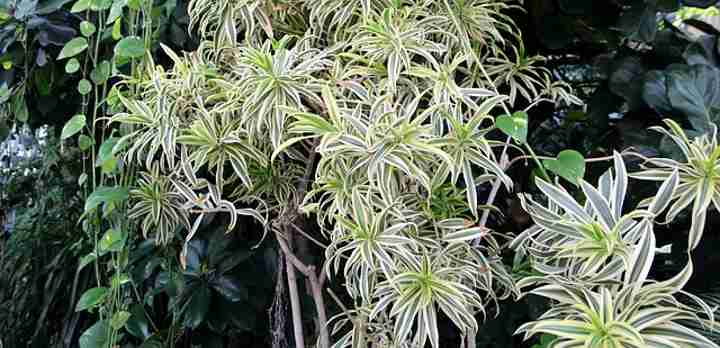
Spider plant is a popular shallow-rooted houseplant known for its clumps of long, arching, strap-shaped leaves with white stripes. This easy-care houseplant has leaves growing up to 18” (45 cm) long. Also, long, wiry stems 24” (60 cm) appear and produce plantlets that look like mini spider plants.
Spider plants prefer bright, indirect light but can tolerate low-light conditions. Because of their arching leaves, they are popular hanging basket plants for average humidity and cool temperatures. Although it’s a flowering plant, its star-shaped white flower rarely appears.
- USDA Growing Zone: 9 to 11, but typically grows as a houseplant
- Light: Dappled sunlight to deep shade outdoors and bright, indirect light indoors
- Watering Needs: Allow to dry out between waterings
- Soil Needs: Well-draining potting mix
Wax Plants (Hoya carnosa)
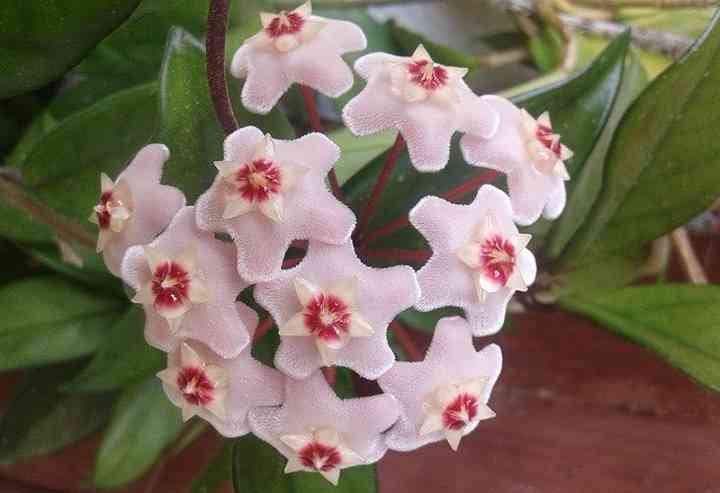
Wax plants are unique, attractive houseplants prized for their waxy leaves on trailing vines and star-shaped flowers pinkish-white flowers. Hoyas are epiphytic plants; therefore, they have shallow root systems. Varieties of hoya carnosa can have thick, fleshy, lanceolate, or heart-shaped leaves measuring up to 2” (5 cm) long.
The flowers of the wax plant are typically white or pink and have a sweet, delicate fragrance. They bloom in umbel clusters and can last for several weeks. They have a porcelain appearance, giving them the name porcelain flowers. Wax plant vines look attractive in hanging baskets or trailing down from a shelf.
- USDA Growing Zone: 10 to 12
- Light: Bright, indirect light
- Bloom Time: Throughout the year
- Watering Needs: Allow the top inch of soil to dry out between waterings
- Soil Needs: Well-draining potting mix
Philodendron (Philodendron)
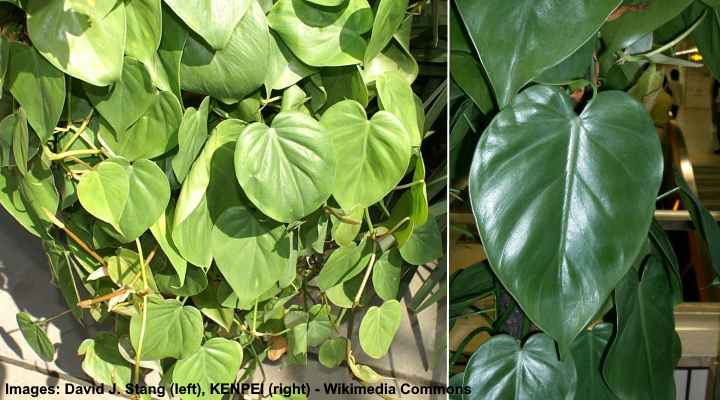
Philodendrons are some of the easiest foliage houseplants to grow indoors. Due to their rooting system, they thrive in shallow, wider pots to allow the shallow roots room to spread. Most philodendron types have attractive, glossy foliage, heart-shaped rounded to oblong leaves, and easy care requirements. They grow 1 to 3 ft. (0.3 – 0.9 m) long.
These tropical plants thrive in indirect light, making them perfect for indoor environments. Philodendron leafy plants look attractive with their lush vines cascading over hanging baskets or climbing moss poles. With nearly 500 species of philodendron, each with distinctive leaf shapes, patterns, and growth habits, you can find an easy-care houseplant to add greenery to your indoor space.
Their lush, green leaves can purify the air, adding both beauty and health benefits to home spaces. Philodendrons are known for their easy care and fast growth, appealing to both novice and experienced plant enthusiasts. These plants are adaptable and can tolerate lower light levels, though brighter light encourages more vibrant growth.
- USDA Growing Zone: 9 to 11 (outdoors)
- Light: Medium to bright indirect light
- Watering Needs: Allow the top inch of soil to dry out between watering the potting soil
- Soil Needs: Well-draining potting mix high in organic matter
Jade Plant (Crassula ovata)
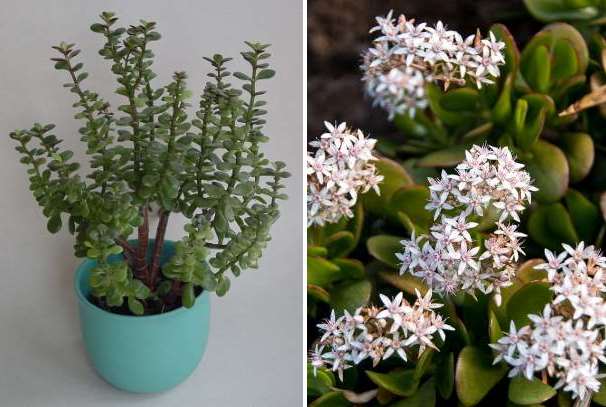
Jade plant—or Chinese rubber plant—is a popular evergreen houseplant with thick, fleshy, egg-shaped leaves. Native to dry, desert climates, the succulent plant has a shallow, spreading root system. It grows woody stems with bushy foliage that thrives in dry potting soil, bright light, and cool temperatures.
The slow-growing foliage plant grows 3 to 6 ft. (0.9 — 1.8 m) tall and up to 3 ft. (0.9 m) wide. Due to its intolerance of the cold, it grows best as a tropical houseplant. A symbol of good luck, its minimal care requirements and watering needs make jade plants ideal for beginners. In bright light, its green foliage develops flushes of red and burgundy.
- USDA Growing Zone: 10 to 11
- Light: Bright, indirect light
- Watering Needs: Allow soil to dry out between waterings and only water occasionally
- Soil Needs: Well-draining cactus or succulent soil that dries easily
Lipstick Plant (Aeschynanthus radicans)

The lipstick plant is an evergreen perennial with a shallow root system, making it perfect for shallow pots. It’s known for its glossy green leaves and bright, tube-shaped red flowers. These flowers emerge from dark, maroon buds, resembling a tube of lipstick, hence its name. The plant thrives in humid conditions and can bloom several times a year with proper care.
Due to its shallow roots, the lipstick plant is ideal for indoor hanging baskets or wall planters. It prefers bright, indirect light and regular watering, but allows the soil to dry out between waterings. This plant’s trailing habit and unique blooms add a tropical flair to any space. It’s not only visually appealing but also easy to care for, making it a popular choice for indoor gardeners.
- USDA Growing Zone: 10 to 12
- Light: Bright, indirect light
- Bloom Time: Periodically throughout the year
- Watering Needs: Keep evenly moist in summer, reduce watering in winter
- Soil Needs: Well-drained, rich organic mix
Herbs with Shallow Roots
Basil (Ocimum basilicum)

Basil, a fragrant annual herb with shallow roots, thrives in warm, sunny conditions, making it perfect for shallow pots and herb gardens. Its aromatic leaves are a staple in culinary dishes worldwide, particularly in Italian cuisine. Basil plants are compact and bushy, featuring glossy, green leaves that can be harvested throughout the growing season. This herb not only enhances recipes but also attracts pollinators with its small, white flowers when allowed to bloom.
Ideal for kitchen gardens and windowsills, basil requires regular watering and well-drained soil to prevent root rot. It prefers full sun and warm temperatures, growing quickly in the right conditions. Pinching off the tip growth encourages a bushier plant and prolongs leaf production. Basil’s ease of care and culinary versatility make it a favorite among gardeners and cooks alike.
- USDA Growing Zone: 2 to 11 (as an annual)
- Light: Full sun
- Bloom Time: Summer (if allowed to flower)
- Watering Needs: Keep soil consistently moist
- Soil Needs: Rich, well-drained soil
Cilantro (Coriandrum sativum)

Cilantro, also known as coriander, is an annual herb with shallow roots, well-suited for shallow pots and culinary gardens. Its distinctive, pungent leaves are widely used in Mexican, Asian, and Middle Eastern cuisines. Cilantro grows quickly in cool, moist conditions, producing delicate, lacy green leaves and later, aromatic seeds. This dual-purpose plant provides both a fresh herb and a spice, making it a versatile addition to the garden.
Cilantro prefers cool temperatures and can bolt to seed in hot weather, so it’s best planted in spring or fall. It requires regular watering to keep the soil moist but well-drained, preventing soggy conditions. Full sun to partial shade and rich, loamy soil encourage lush growth. Frequent harvesting of the leaves encourages the plant to produce more foliage. Cilantro’s rapid growth cycle and shallow roots make it an ideal choice for those looking to add fresh flavor to their cooking.
- USDA Growing Zone: 2 to 11
- Light: Full sun to partial shade
- Bloom Time: Late spring to early summer
- Watering Needs: Keep soil consistently moist
- Soil Needs: Well-drained, fertile soil
Chives (Allium schoenoprasum)

Chives, perennial herbs with shallow roots, are perfect for shallow pots and herb gardens. Their slender, hollow leaves and purple flowers offer both culinary and ornamental value. Chives thrive in full sun to partial shade, producing a mild, onion-like flavor that enhances dishes without overpowering them. The plant forms dense clumps and can be harvested throughout the growing season for fresh use.
Ideal for borders or as a low-growing companion plant, chives require minimal care. They prefer well-drained soil and regular watering, especially in dry conditions. Chives can also deter pests, making them beneficial in vegetable gardens. Deadheading the flowers encourages more leaf growth. Chives are not only easy to grow but also reseed themselves, providing a continuous supply.
- USDA Growing Zone: 3 to 9
- Light: Full sun to partial shade
- Bloom Time: Spring to early summer
- Watering Needs: Moderate, consistent moisture
- Soil Needs: Well-drained, fertile soil
Thyme (Thymus spp.)

Thyme is a perennial herb with shallow roots, ideal for shallow pots, rock gardens, and as ground cover. Its tiny, aromatic leaves and woody stems offer culinary and ornamental appeal. Thyme thrives in full sun and well-drained soil, forming dense mats that bloom with small, bee-attracting flowers. This drought-tolerant plant is perfect for adding flavor to dishes and creating fragrant, low-maintenance landscapes.
Requiring little care once established, thyme prefers lean, rocky soil and minimal watering. It’s suitable for xeriscaping, borders, and paths, releasing a pleasant scent when trodden upon. Thyme’s shallow root system and tolerance for poor soil make it adaptable to various garden settings. Regular trimming encourages bushier growth and prevents woody stems.
- USDA Growing Zone: 5 to 9
- Light: Full sun
- Bloom Time: Early to mid-summer
- Watering Needs: Low, drought-tolerant once established
- Soil Needs: Well-drained, preferably sandy or rocky soil
Swiss Chard (Beta vulgaris subsp. vulgaris)
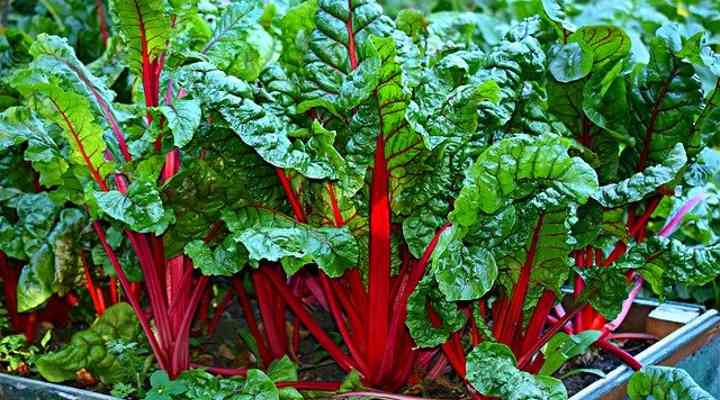
Swiss chard, a leafy green with shallow roots, is ideal for shallow pots and raised beds. Its large, crinkly leaves and colorful stalks add beauty to edible landscapes. Chard tolerates poor soil, heat, and light frosts, making it versatile for year-round planting. This nutrient-rich vegetable offers a mild, spinach-like flavor and can be harvested from late spring through fall.
Perfect for small gardens, Swiss chard needs regular watering and partial to full sun. Its shallow root system requires fertile, well-drained soil for optimal growth. Chard can be cut repeatedly, providing a continuous harvest. The plant’s vibrant leaves and stems can brighten up the garden and plate. It’s a hardy, easy-to-grow choice for beginners and seasoned gardeners alike.
- USDA Growing Zone: 2 to 11
- Light: Full sun to partial shade
- Bloom Time: Not applicable
- Watering Needs: Keep soil consistently moist
- Soil Needs: Rich, well-drained soil
Lettuce (Lactuca sativa)

Lettuce, a cool-season crop with shallow roots, is perfect for shallow pots and quick harvests. Its leaves come in various shapes, colors, and textures, making it a versatile choice for salads. Lettuce grows best in cool temperatures, providing fresh greens in spring and fall. The plant prefers short growth periods and can be harvested just a few weeks after planting.
For continuous harvest, plant lettuce in partial shade to slow bolting in warmer weather. It requires moist, well-drained soil and regular watering to keep roots cool and prevent wilting. Lettuce’s shallow root system makes it suitable for small garden spaces and containers. Frequent harvesting encourages new growth, offering a steady supply of fresh leaves.
- USDA Growing Zone: 4 to 9
- Light: Full sun to partial shade
- Bloom Time: Not applicable
- Watering Needs: Consistent moisture
- Soil Needs: Fertile, well-drained soil
Lavender (Lavandula spp.)
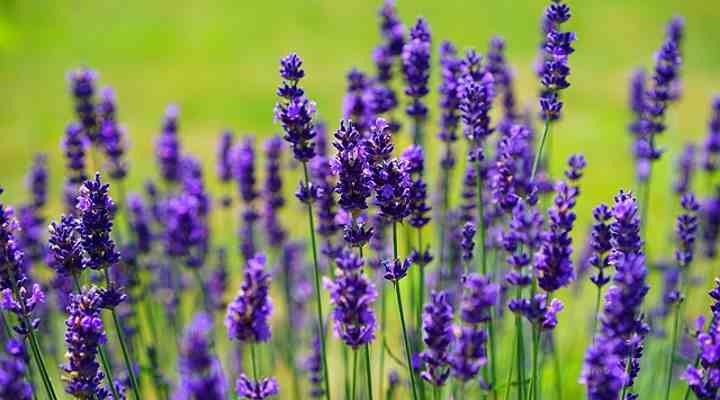
Lavender, a perennial plant with shallow roots, thrives in shallow pots and dry, rocky landscapes. Its fragrant flowers and silvery foliage are beloved in gardens and bouquets. Lavender prefers full sun and well-drained soil, making it ideal for areas prone to drought. This hardy plant resists deer and attracts pollinators, adding beauty and biodiversity.
Suited for borders or herb gardens, lavender requires minimal watering once established. It’s essential to avoid wet, heavy soils to prevent root rot. Pruning after flowering encourages dense growth. Lavender’s aromatic leaves and flowers can be used in cooking, crafts, and aromatherapy, making it a versatile addition to any garden.
- USDA Growing Zone: 5 to 9
- Light: Full sun
- Bloom Time: Late spring to early summer
- Watering Needs: Low, drought-tolerant
- Soil Needs: Well-drained, sandy or gravelly soil
Do Bonsai Trees Have Shallow Roots?

Bonsai trees are cultivated specifically to have restricted root growth to maintain their miniature size, which involves regular root pruning and potting in shallow trays or pots. This practice encourages the development of a compact, shallow root system that can thrive in the limited space provided by the bonsai container. So, in the context of their cultivation and maintenance, bonsai trees can be considered as having shallow roots, designed to support the health and aesthetic of the miniature tree within the confines of a shallow container.
Bonsai trees, with their shallow root systems, are meticulously cultivated to remain small. This ancient art form from Japan allows gardeners to create a miniature landscape. By carefully pruning the branches and roots, enthusiasts can shape trees into elegant forms. Bonsai trees symbolize harmony, peace, and balance, making them more than just plants—they are living sculptures.
Caring for bonsai trees involves precise watering, sunlight, and soil conditions. They require well-drained soil and should be watered when the top layer feels dry. Placement in bright, indirect light helps them thrive. Each species has unique needs, but all share a dependence on careful attention to mimic natural growth patterns in miniature form. Bonsai trees are a commitment to art and nature, offering beauty and satisfaction to those who nurture them.
Relating article:
- Plants That Thrive Under Evergreen Trees
- Evergreen Ground Cover Plants for Sun or Shade
- The Best Closed Terrarium Plants
